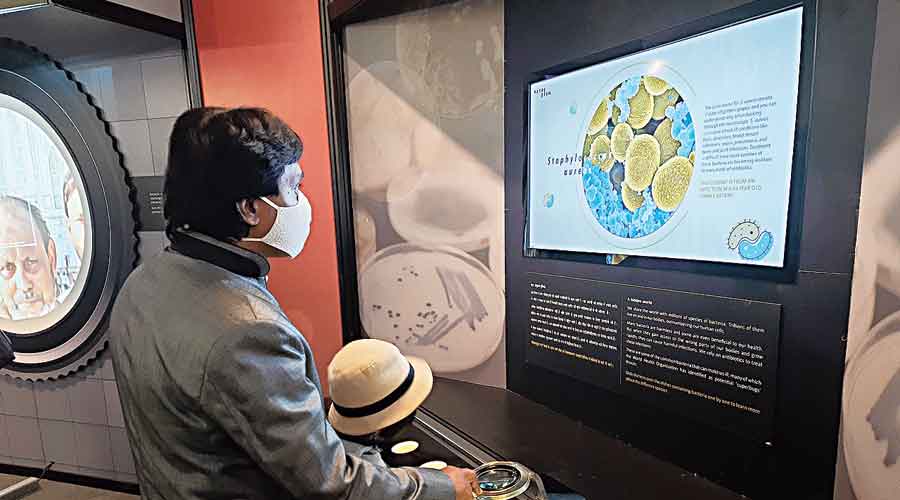As the world fights Covid-19, another pandemic is looming in the horizon. This will be caused by bacteria which are becoming resistant to the entire gamut of antibiotics discovered so far, rendering humankind and animals defenceless against infections.
A travelling exhibition, titled Superbugs: The End of Antibiotics?, reached Science City on Monday after doing the rounds of Delhi, Mumbai and Bangalore.
Organised by the National Council of Science Museums (NCSM), in collaboration with Science Museum Group, London, Wellcome, UK, and supported by the Indian Council of Medical Research, it will be on view through February.

A pneumothorax apparatus used to treat tuberculosis before the BCG vaccine became popular in the 1940s
The exhibition consists of 30 exhibits divided into three segments — microscopic, human and global.
“The first part tells the story of the hidden world of bacteria and the history of antibiotics. The human section deals with those affected by and combating antibacterial resistance. The third is on global initiatives in search of new antibiotics and alternative solutions,” said Subhabrata Chaudhuri, director, Science City.
The first section starts with an innocuous picture of a man posing in front of Taj Mahal. A wheel in front of the digital panel on being turned zooms in manifold on his head, till single strands of hair and finally a bacteria under his skull become visible. “That’s just 1 micron in size. This has been devised to show how small bacteria are,” said curator S.S. Ghosh, while showing guests around.

A panel on Alexander Fleming, who discovered penicillin, the world’s first antibiotic, in 1928
There are 10 original bacterial slides in petri dishes, collected mostly from patients at Tata Medical Center. Once a sliding magnifying glass is held over each dish, the shape and other details of the bacteria appear on the panel in front. Two petri dishes in an adjacent exhibit show how an antibiotic has killed and stopped growth in a colony of Staphylococcus aureus in one, and how bacteria resistant to the antibiotic have kept growing in the other.
On picking up a vintage telephone handset, one can hear the voice of Alexander Fleming, the discoverer of the world’s first antibiotic penicillin, predicting the rise of superbugs as part of his Nobel Prize acceptance speech in 1945.
A penicillin mould grown from Fleming’s original sample is on display, alongside a picture of Albert Alexander, a police officer who was the first to receive penicillin. Passing a hand over a sensor-fitted book allows one to flip panels in front, showcasing trivia like Winston Churchill being cured of pneumonia by a newly discovered antibiotic in 1943.

Visitors read details on original bacterial slides
Recalling how the exhibition was conceptualised, Arijit Dutta Choudhury, director general, NCSM, said: “In 2018, we were approached by Science Museum, London, to develop an exhibition on the subject. They held one in London which our team visited. Their exhibition also travelled to China. We contextualised it to fit the Indian situation and opened it in September 2019 in Delhi. It was kept in abeyance because of the lockdown. This exhibition has been visited by five lakh people across the country and we reached out digitally to another 10 lakh.”
Scientists attending the inauguration pointed out how because of Covid-19, people have started taking plenty of antibiotics, aggravating the problem. Emdadul Islam, a retired director of the Birla Industrial and Technological Museum, pointed out that no new antibiotic had been developed since the 1970s. “If the ones we have become ineffective, no surgery can be done for fear of infection,” he said.
Human geneticist Partha Pratim Majumdar, National Science Chair of the government of India, who inaugurated the exhibition, warned against both overuse, when people take antibiotics without being prescribed, and underuse, when they stop before completing the course. He also rued the rampant use of antibiotics in poultry farms and crop plants.
“These are secondary ways in which antibiotics enter the human body and promote resistance. It is a man-made disaster. We need to use antibiotics more responsibly.”
Microbiologist Sanjay Bhattacharya of Tata Medical Center also spoke at the programme, as did three other experts virtually.
“We will hold programmes like puppet show, online quiz, poster making on the sidelines,” said Samarendra Kumar, director, headquarters, NCSM.











